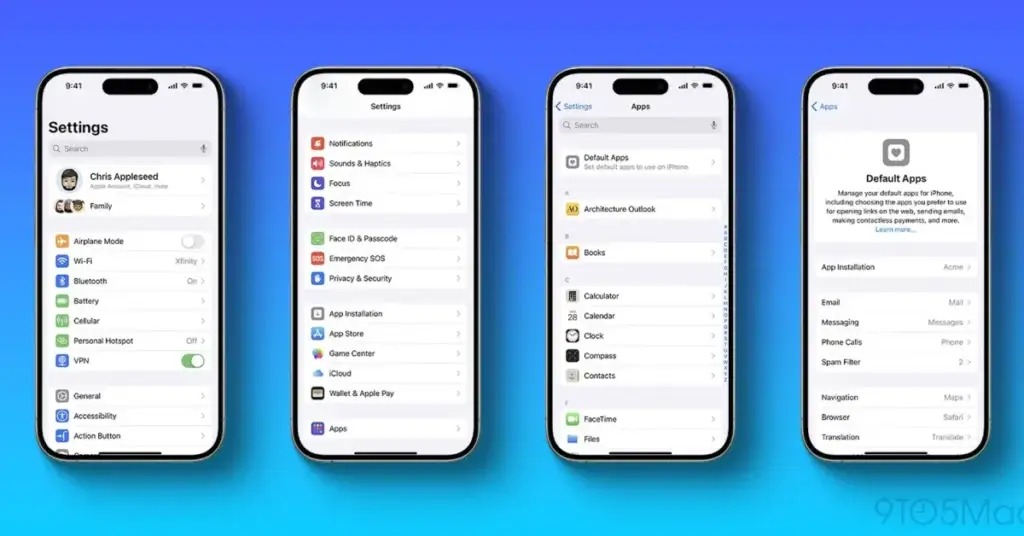For years, Apple has limited customization features on iPhones. However, the release of iOS 18.2 marks a significant shift. Now, iPhone users have the ability to choose their preferred apps for calling and messaging. Initially, this update was anticipated to be exclusive to the EU, but Apple has fortunately extended it worldwide. In this guide, I’ll walk you through the steps to change your iPhone’s default calling and messaging apps using iOS 18.2.
Introduction to Default App Settings in iOS 18.2 update
The iOS 18.2 update delivers an important feature for iPhone users. Apple has added a new “Default Apps” section within Settings. For the first time, iPhone users have the ability to choose their preferred calling and messaging apps as defaults. This update offers greater flexibility and control to iPhone users, aligning more closely with the customization options available on Android devices. Here’s how you can effortlessly change these default apps on your iPhone.
How to Change the Default Calling App on Apple iPhone
Switching the main calling app on an iPhone is easy with iOS 18.2. Here’s how you can set your favorite calling app as the default:
- To start, access the Settings on your iPhone.
- Next, scroll down and select Apps.
- At the top, you’ll see Default Apps; click on it.
- Select Calling to see a list of supported calling applications.
- Select the application you wish to set as the default from the list.
This update simplifies the process for users to change their primary calling app, but it currently supports only those compatible with Apple. Regrettably, well-known third-party apps such as Truecaller cannot yet be set as default. We remain optimistic that Apple will include more choices in upcoming updates.
How to Change the Default Messaging App on iPhone
Switching your default messaging app is equally straightforward. Follow these steps to make your favorite messaging app the default on iOS 18.2:
- Launch the Settings application on your iPhone or iPad.
- Go to the Apps section, then select Default Apps.
- Now, open Messages to view the available chat applications.
- Choose your favorite application from the list.
Apple has streamlined this process. With just a few taps, you can now change your default messaging app. As with the calling app choices, only Apple-approved messaging apps are currently listed. Third-party messaging apps aren’t available as default options yet, but Apple might include them in future updates.
Additional Default Apps You Can Change in iOS 18.2
iOS 18.2 goes beyond just calling and messaging applications. The update provides users with the ability to modify defaults for a variety of other apps. Below is a compilation of all the app categories you can designate as default in iOS 18.2:
- Email: Choose your favorite email application as the primary one.
- Messaging: Select a standard messaging application on your iPhone.
- Calling: Choose a standard app for making all your phone calls.
- Call Filtering: Choose an application to block unwanted calls.
- Browser App: Choose your preferred web browser as the default option.
- Passwords & Codes: Utilize a reliable application to manage your passwords securely.
- Keyboards: Select your primary keyboard for effortless typing.
With a wide array of choices, iOS 18.2 provides a more tailored experience. The new Default Apps hub consolidates everything into a single location, allowing users to access and manage these settings effortlessly.
This update narrows the gap between iPhone and Android devices in terms of customization. Nevertheless, Apple continues to limit the ability of third-party apps to become defaults. Users might need to anticipate future updates for greater flexibility.
The “Default Apps” Feature in Settings
Apple’s latest addition, the “Default Apps” feature, is set to revolutionize the experience for iPhone users. Found in the Settings app within the Apps section, it consolidates all options for default applications into a single, easily accessible location.
At first, it seemed this update would be available only in the European Union. However, Apple astonished users by making it accessible worldwide. Before, users were restricted to using the standard Apple applications. Now, they have the option to choose from a select group of Apple-approved apps. Apple may increase these choices in the future.
This shift in Apple’s strategy indicates an increasing focus on user preferences. The Default Apps feature not only boosts user autonomy but also makes device management easier.
Limitations of the Default Apps Feature
Although the Default Apps feature offers advantages, it has certain drawbacks. At present, only apps that are compatible with Apple are available as default choices. Consequently, users are unable to choose well-known third-party apps such as WhatsApp or Truecaller.
The choices are currently confined to Apple’s applications like FaceTime and Messages. Despite these restrictions, Apple’s openness to customization is an encouraging development. Upcoming updates might permit additional third-party apps to be set as defaults.
Some users might find these restrictions annoying. Nevertheless, the new Default Apps feature is a positive development. Apple has traditionally limited customization, so this update represents advancement. Many iPhone users value the increased flexibility, despite the limited choices available.
The Final Words
The iOS 18.2 update brings a much-appreciated improvement for iPhone owners. By allowing users to choose their preferred calling and messaging apps, Apple has moved towards a more user-centric approach. Although the options are still somewhat restricted, this update introduces the kind of adaptability that iPhone users have been yearning for.
Although the choices are currently limited to apps that work with Apple devices, upcoming updates could introduce more options from outside developers. The Default Apps section in Settings simplifies managing your device, making it user-friendly. For iPhone users seeking more control, this update is an excellent beginning.
For up-to-date technology updates, follow Hogatoga on Twitter, Facebook, and Google News. To stay informed with our tech videos, subscribe to our YouTube Channel and Newsletter.
